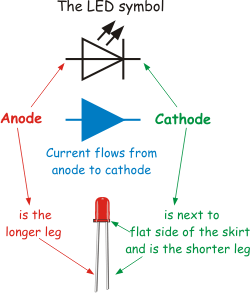
|
Introduction to Microcontroller Programming
About PICmicro Chips
Clocking Your PICmicro Devices E-Blocks Flowcode Step By Step
PICmicro Projects
Labs |
Using LED's<^< LED's | Course Index | 7seg Displays >^> LED's are very robust mechanically, compared to glass-encased filament lamps. However, electrically it is the other way round! LED's are a form of diode. A diode will pass electric current in one direction only. The symbol indicates this - the arrow in the symbol shows the allowed direction of current flow, called the forward direction.  Electric current flows from positive to negative around the circuit, and from anode to cathode in the led, when the LED is biased correctly, in the forward direction. ('Biased' means 'connected to a voltage supply'.) The LED will be damaged if too much electric current passes through it in the forward direction, however, or if too great a voltage is applied to it in the reverse direction (trying to make current flow the wrong way through the LED.) The LED is protected from excessive current in the forward direction by connecting it in series (in line) with a resistor. The value of this resistor depends on the power supply voltage used. The table gives recommended sizes for this resistor.
 When there is a risk of excessive voltage in the reverse direction, a 'normal' (i.e. not light-emitting,) diode can be connected as shown to protect the LED. (The normal diode is forward biased, and so conducts a current. The voltage across the diode then drops to 0.7V, a small enough reverse voltage for the LED to cope with.) <^< LED's | Course index | 7seg Displays >^> |